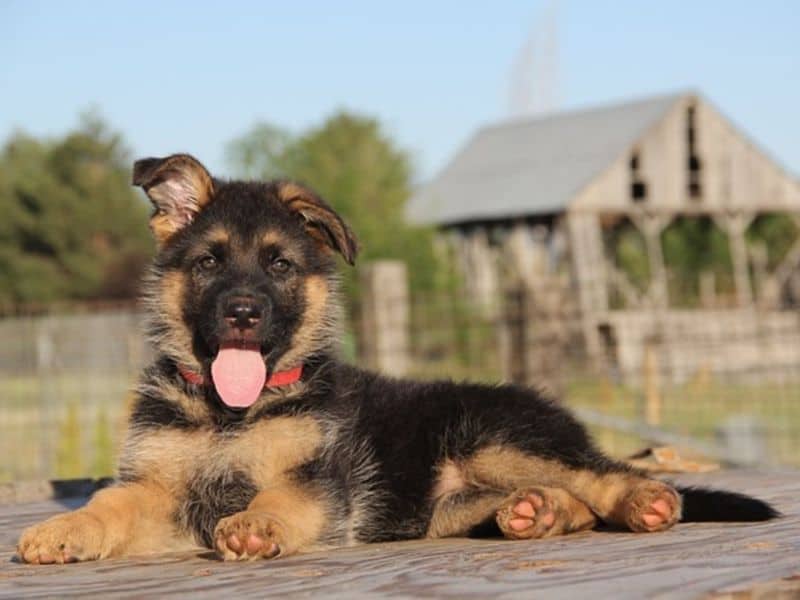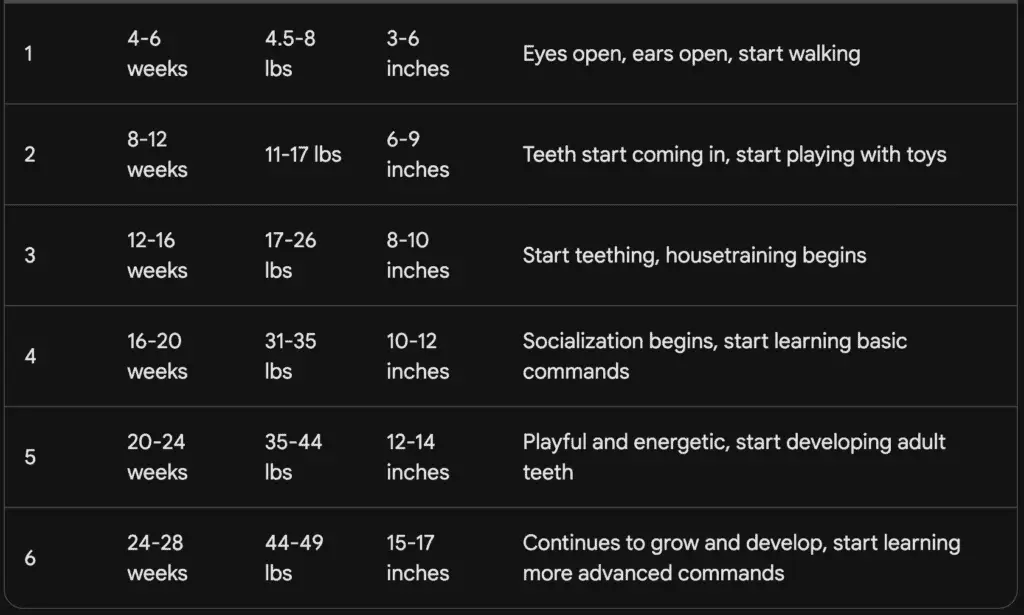A 6-month-old German Shepherd is a bundle of energy, curiosity, and potential. With the right balance of care, training, and patience, they will grow to become loyal, loving, and incredibly intelligent companions.

If you have a new German Shepherd puppy, as your puppy grows from months 2-5, you’ll soon notice that your once docile German Shepherd puppy has suddenly become more headstrong and independent.
This behavior is normal for a 6-month-old German Shepherd, similar to the ‘rebellious teenager’ phase in humans.
At this age, they are developing their personalities and exploring the boundaries of their world. This stage can be challenging for owners, but you can navigate it successfully with patience, consistency, and positive reinforcement.
Let’s embark on a fascinating journey through the first six months of a German Shepherd puppy’s life, understanding their month-by-month physical growth, behavioral changes, exercise needs, eating habits, and trainability.
Month-by-Month Development of a German Shepherd Puppy


Month 1 – German Shepherd Puppy Development:
During their first month, German Shepherd puppies are incredibly small, delicate, and entirely reliant on their mother. This period marks the beginning of their journey, characterized by significant developmental milestones.
Their eyes and ears, initially sealed, will start to open, introducing them to a whole new world of sights and sounds. Puppies begin exploring their immediate surroundings, albeit clumsily.
Their weight at this stage usually ranges from 4 to 9 pounds. Early socialization also begins in the litter with their mother and siblings, providing the first lessons in canine communication and behavior.
Month 2 – German Shepherd Puppy Development:
German Shepherd puppies become noticeably more active and lively by their second month. They start engaging in early play behaviors with their siblings, learning vital skills through these playful interactions.
This month also marks the time for their first set of vaccinations, an important step in ensuring their long-term health.
At this stage, puppies are exceptionally receptive to socialization, making it an ideal time to expose them to various gentle experiences, including different sights, sounds, and handling by caring humans.
Month 3 – German Shepherd Puppy Development:
Three-month-old German Shepherd puppies are bundles of energy, displaying an insatiable curiosity about their environment. Their explorative nature is paired with an eagerness to learn, making it the perfect time to initiate basic obedience training.
Commands like “sit,” “stay,” and “come” can be introduced at this stage. Their dietary needs continue to increase, and they should be fed high-quality puppy food four times a day to support their rapid growth. Typical weight at this age can vary but often lies around 22-30 pounds.
Month 4 – German Shepherd Puppy Development:
The fourth month is a time of rapid growth and developing confidence for German Shepherds. Their curiosity about the world around them remains high, and they may start to push boundaries, testing their owners and their environment.
Consistent, positive reinforcement-based training becomes even more crucial during this phase to shape good behavior and curb any potential behavioral issues.
This month, they also start teething, losing their puppy teeth to make way for their adult dog set. Providing appropriate chew toys can help alleviate any discomfort associated with this process.
Month 5 – German Shepherd Puppy Development:
At five months old, your German Shepherd’s growth rate begins to slow a bit, but its need for physical exercise does not.
They have plenty of energy at this stage, so multiple short walks and periods of play each day are recommended to keep them happy and healthy. Their mental capabilities continue to expand, and training can incorporate more complex commands and tasks.
Their increasing intelligence and ability to learn make this a prime time for advancing their training. Weight is individual, but many five-month-old German Shepherds will weigh between 50-60 pounds.
Month 6 – German Shepherd Puppy Development:
By the sixth month, your German Shepherd enters adolescence. This period can be marked by signs of stubbornness and a newfound sense of independence. Your puppy may begin to test boundaries even more during this time, attempting to find their place in the world.
The importance of firm but fair rules and consistent training cannot be overstated during this phase. Their need for physical exercise remains high, often requiring over an hour of exercise each day.
A high-quality, large-breed puppy diet remains crucial for their development, with typical weights ranging from 55-70 pounds.
Socialization should also continue to be a focus, exposing the pup to different environments, people, and situations to ensure they grow into well-rounded adult dogs.
What You May Be Shocked To Know About Your 6-Month-Old German Shepherd Puppy
One shocking fact about a 6-month-old German Shepherd is their size. Despite being just halfway through their first year of life, a German Shepherd puppy could potentially be half the size of an adult dog or even more.

Their swift growth is a clear testament to their future stature as one of the larger dog breeds.
Reinforcing Training In Your 6-month-old German Shepherd: From Basics to Beyond
By now, your German Shepherd puppy (GSD puppy) should have grasped the basic commands. However, this doesn’t mean you should stop training.
It’s an opportune time to introduce more advanced training, such as agility exercises, scent detection games, or more complex commands.
Remember, training sessions should be engaging and rewarding.
According to a Frontiers in Veterinary Science study, dogs are more responsive to reward-based training. It helps build a positive relationship between the dog and the owner and reduces stress, enhancing the overall learning experience.
Socialization: A Key Aspect of Puppy Development
Continued socialization is crucial for a 6-month-old GSD puppy. Socializing your pup from a young age can result in a more confident, well-adjusted adult dog. This includes exposure to different environments, people, and other animals.
It’s important to note that a six-month-old German Shepherd puppy might show signs of fear or wariness around new experiences. This could be part of a ‘fear period’, a normal stage of puppy development.
Always ensure that new experiences are positive and non-threatening, and never force your puppy into a situation where they feel uncomfortable.
Nutrition: From Puppy Food to Adult Food
Feeding a six-month-old GSD puppy requires attention to detail. According to the American Kennel Club (AKC), a German Shepherd puppy should continue on puppy-specific food until they reach 80-90% of its adult size.
This is because puppy food contains higher levels of protein, fat, and certain vitamins and minerals to support their growth and development.
As a general guideline, a six-month-old German Shepherd needs about 3 cups of puppy food each day, divided into two meals. However, this amount may vary based on their individual activity level, metabolism, and overall health.
Remember, sudden changes in diet can upset your puppy’s stomach. When it’s time to transition to adult food, do it gradually over a week or two, slowly mixing in the adult food with the puppy food.
Health and Veterinary Care: Regular Check-ups
Keeping up with regular veterinary care is essential for your six-month-old German Shepherd’s health. At this age, your puppy should have completed their series of vaccinations, including distemper, parvovirus, and rabies.
Regular check-ups allow the vet to monitor your puppy’s growth and development, check for any potential health issues, and provide necessary preventative care like heartworm or flea and tick prevention.

Discuss spaying or neutering with your vet. This procedure can have health and behavioral benefits, including reducing the risk of certain types of cancer and unwanted behaviors related to sexual maturity.
However, it should be timed properly, especially in large breed dogs like German Shepherds.
Exercise: Balancing Physical Activity and Mental Stimulation
Exercise is vital for a six-month-old German Shepherd, not only for their physical health but also for their mental well-being.
A combination of physical exercises, such as walks and play sessions, and mental stimulation, such as training and interactive toys, can help keep your German Shepherd healthy and happy.
Be mindful of their growing bones and joints. Overexercising at this age could potentially lead to joint issues, including hip or elbow dysplasia.
According to the Orthopedic Foundation for Animals, German Shepherds rank among the top breeds for hip dysplasia, with about 19.1% affected.
Regular, moderate exercise is safer and more beneficial for your puppy’s development than intense, sporadic activities.
Six-Month Milestone: How Male and Female German Shepherds Differ
While German Shepherds as a breed share many common characteristics, there can be striking differences between male and female dogs, particularly as they hit the six-month mark.
German Shepherd Weight and Size:
Male German Shepherd puppies tend to be larger than their female counterparts in terms of size and weight. A six-month-old male puppy typically weighs between 50-70 pounds and stands approximately 18-20 inches tall at the shoulder.
On the other hand, female puppies are usually a bit smaller, with weights ranging from 45-60 pounds and standing about 17-19 inches tall. However, remember that these figures can vary based on individual genetics and diet. This is no different than other dogs, a German Shepherd’s weight should be monitored.
Temperament and Behavior:
While both male and female German Shepherds are known for their loyalty, intelligence, and protective nature, subtle variations in temperament may become more noticeable at six months.
Male dogs often display more dominant and territorial behavior, particularly around other male dogs. They might be more inclined towards establishing a hierarchy and marking their territory.

A Female German Shepherd dog, in contrast, are often characterized as more focused and easy to train at this age. They may demonstrate quicker maturity compared to their male counterparts and are sometimes seen as less distracted during training sessions. However, they can also be independent and may become reserved around strangers.
Interaction with Other Dogs:
Interactions with other dogs can also reveal differences between male and female puppies. Male puppies can become more assertive at this age, particularly around other male dogs.
They may be more likely to engage in dominance-related behaviors such as marking or posturing. This characteristic could become more pronounced if the male puppy is not neutered.
On the other hand, female German Shepherd dogs may exhibit less aggression towards other dogs. However, they might have periods of mood changes due to their heat cycles, which can start anytime from six months onwards.
Female German Shepherd vs. Male German Shepherd Round-up
While male and female German Shepherd puppies make excellent companions, understanding these differences can help potential dog owners make informed decision based on their living situation, family dynamics, and personal preferences.
It’s also important to remember that individual temperament and behavior can vary greatly within a breed, and a dog’s upbringing, socialization, and training play significant roles in shaping its personality.
German Shepherd Facts and Figures
Did you know that German Shepherds rank as the second most popular dog breed in the United States? Their intelligence, loyalty, and trainability have won the hearts of many.
These characteristics also make them excellent working dogs, commonly seen in roles such as police dogs and search and rescue dogs. They typically live between 10-13 years, providing a substantial period for loving and fulfilling companionship.
More on Size and Appearance
To recap, here are the typical measurements for a 6-month-old German Shepherd:
- Height: 16-18 inches at the withers
- Weight: 40-50 pounds
- Coat: Thick, developing double coat
- Colors: Varying, including black, black and tan, sable, white, and blue
Final Thoughts: Your Role as a German Shepherd Owner
As an owner of a six-month-old German Shepherd, your role is crucial in shaping your puppy’s future. Your puppy will grow into a confident, well-behaved, and healthy adult dog with your guidance and care.
Despite the challenges of this stage, it’s also a time of bonding and discovery. Enjoy the journey, and remember, patience and consistency are key. German Shepherds are known for their intelligence and loyalty, which will surely make all your efforts worthwhile.
Your 6-month-old German Shepherd is in a significant period of their life, but with love, consistency, and guidance. They’ll successfully navigate this stage and develop into the reliable, brave, and loving dogs German Shepherds are known to be.
FAQ 6-month-old German Shepherd
1. What are the physical changes that a 6-month-old German Shepherd will go through?
At 6 months old, your German Shepherd puppy will be about 25-30% of their adult size. Males will typically be larger than females. Their height will be about 16-18 inches at the withers, and their weight will be about 40-50 pounds. Their coat will start to fill out, and they may start to shed their puppy coat.
2. What are the behavioral changes that a 6-month-old German Shepherd will go through?
6-month-old German Shepherds are entering adolescence, which can be challenging for both dogs and dog owners. They may start to test their boundaries and exhibit some unwanted behaviors. It is important to be firm and consistent with them during this time.
Some common behavioral changes that 6-month-old German Shepherds may exhibit include increased independence, destructive behavior, and aggression.
3. What are the dietary needs of a 6-month-old German Shepherd?
At 6 months old, your German Shepherd puppy will need to eat high-quality puppy food. The food should be specifically formulated for large breed puppies. You should feed your puppy 3-4 times per day.
The amount of food you feed your puppy will depend on their weight and activity level. Monitoring your puppy’s weight and adjusting their food intake is important.
4. What are the training needs of a 6-month-old German Shepherd?
6-month-old German Shepherd puppies are intelligent dogs, but they can also be stubborn. It is important to use positive reinforcement training methods with them.
This means rewarding them for good behavior and ignoring or redirecting bad behavior. You should start teaching your 6-month-old German Shepherd basic commands like sit, stay, come, down, heel, and advanced commands like fetch and roll over.
5. What are the health concerns of a 6-month-old German Shepherd?
Some common health concerns of 6-month-old German Shepherds include Panosteitis, Hip dysplasia, Elbow dysplasia, and allergies. Taking your 6-month-old German Shepherd to the vet for regular check-ups is important to identify and treat any health concerns early.
6. What are the socialization needs of a 6-month-old German Shepherd?
Socialization is important for all puppies, but it is especially important for German Shepherds. They need to be exposed to a variety of people, places, and things so that they can learn to be well-rounded dogs.
You can socialize your 6-month-old German Shepherd by taking them for walks in different neighborhoods, taking them to the park, introducing them to new people, and taking them to puppy classes.
7. What are the exercise needs of a 6-month-old German Shepherd?
German Shepherds are a high-energy breed and require plenty of exercise. At six months old, your German Shepherd should have several short walks along with a play session each day. Remember to keep exercises controlled since their bodies are still growing.
8. How do I deal with my 6-month-old German Shepherd’s teething?
Around this age, German Shepherds are in the process of losing their puppy teeth and gaining their adult ones. You’ll want to provide plenty of appropriate chew toys to help them through this process.
9. How important is mental stimulation for a 6-month-old German Shepherd?
Mental stimulation is just as important as physical exercise for a German Shepherd puppy. Incorporating puzzle toys, obedience training, and socialization can help keep your puppy’s mind sharp.
10. How should I handle my 6-month-old German Shepherd’s fear periods?
Around six months, German Shepherds may go through fear periods. During these periods, providing positive experiences is important as avoiding pushing your puppy too far out of its comfort zone. Be patient and supportive during this time.
11. What should I know about neutering or spaying my 6-month-old German Shepherd?
It’s a common practice to spay or neuter dogs at six months, but many vets recommend waiting until they’re closer to physical maturity for large breeds like German Shepherds. Always consult with your vet to determine the best timing for your individual dog.


